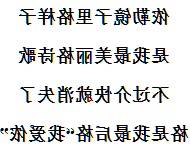Wu love poem
平面镜
侬勒镜子里格样子
是我最美丽格诗歌
不过介快就消失了
格是我最后格“我爱侬”


→ French poem ←
Wu Shanghai language
Wu Love poem, version Shanghai! The shanghainese is the most widely spoken of the Wu dialects, and it is the reference for Wu.
A short quatrain in Wu (Shanghaï), which can be understood by 15 million people!
In this script, you could find all the form of beauty of an Indian ink drawing.
Wu if we count all its dialects, is the most widely spoken language in China after Mandarin, probably by a total of 90 million people.
A pretty Shanghaïenne, one day will compare her reflection, reading herself through this poem first in Wu, and then in Mandarin.
There are 8 language groups in China comprising a multitude of dialects themselves fragmented into local dialects: Wu, northern min, southern min; yue, Xiang, gan and hakka.
The level of intercomprehension between these dialects is almost zero, on the other hand, faced with all these dialects, Chinese writing is a precious factor of unity, because the characters do not transcribe sounds, they are symbols whose pronunciation will be different from one dialect to another.
Wu is a very large set of Chinese languages, usually divided into Northern Wu and Southern Wu.
Very often when they are not sub-dialects, Wu varieties can be considered as distinct languages. In fact, within the same city there is inter-understanding between the variants, on the other hand between two cities we can speak of distinct languages.
There are more than 200 varieties of Wu languages, and maybe half of them are mutually unintelligible.
While people who talk about varieties of Wu around Shanghai can understand Shanghai, the reverse is not true.
In fact, a hundred years ago the Wu Suzhou was such a prestigious language that it was widely spoken in Shanghai, and then many people migrated to Shanghai, especially the Ningbo, it was necessary to find a language understandable by all in Shanghai, and this is how the Shanghainese was created, which evolved in a simplified way to be understood by all.
Today there are several varieties of Shanghainese in its suburbs which are not necessarily inter-understandable; they are Baoshan Wu, Fengxian Wu, Nanhui Wu, Jiading Wu, Jinshan Wu, Pudong or Chuanshan Wu, Songjiang Wu, Qingpu Wu and Pudong Wu which is the first form of Shanghai.
To write Wu shanghai, traditional characters are still used in Hong Kong, Taiwan and Macao, while China has simplified them to the point that they really stand out. Some Chinese dialects have their own characters.Traditional characters are still used in Hong Kong, Taiwan and Macao, while China has simplified them to the point where they really stand out. Some Chinese dialects have their own characters.
Mandarin poemCantonese poem - Taiwanese poem - Hunanese poem - Wu suzhou poem